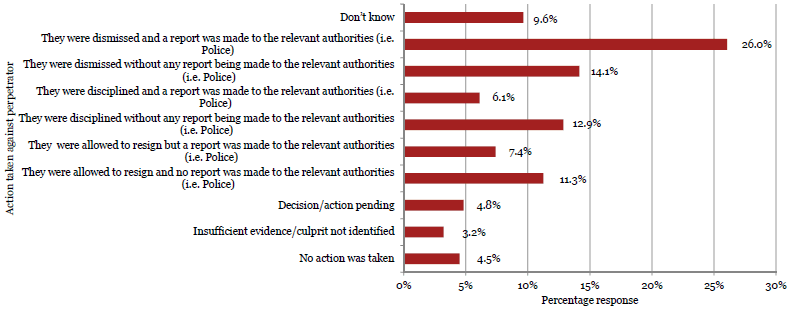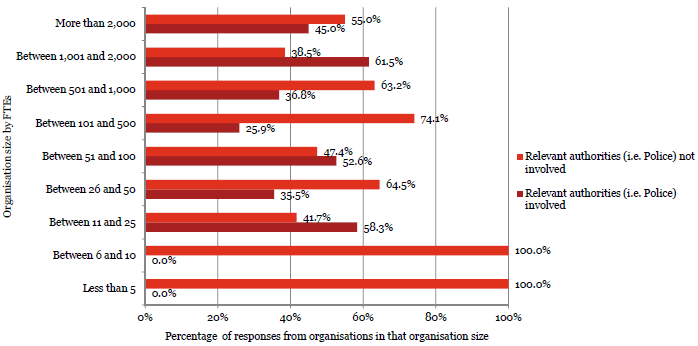40. In the most recent incident of fraud or corruption within your organisation that you are aware of, what action was taken against the perpetrator(s)?
Observation:
Of the 22.5% of respondents who were aware of at least one incident of fraud in their organisation, only 26% indicated that the perpetrator was dismissed and a report made to the Police.

Some examples provided by respondents:
“Supplier removed from contract.”
“The fraud was inaccurate completion of timesheets, which did not align to vehicle GPS records. Disciplinary action undertaken through normal HR processes. As no theft had occurred, we did not report to the Police.”
“They were allowed to resign, I don't know whether report was made to relevant authorities or not.”
“Return of the items to the organisation.”
“Staff member resigned before the investigation could be completed. As no laws were broken (fraud was falsification of internal research data), no report was made to authorities. Sanction was applied via our refusal to provide a reference and our commitment to fully inform prospective employers of the facts. This would effectively end the person's career in scientific research.”
“The individual was required to make restitution and was dismissed from the organisation.”
“He was dismissed and the money repaid.”
“The case went to mediation and is confidential and no report was made to the Police, the employee left the organisation.”
“Dismissed and reparations made, not reported to police due to full recovery.”
“A verbal discussion was had with them, no report and nothing was put on their personnel file.”
| Relevant authorities (i.e. Police) not involved | Relevant authorities (i.e. Police) involved | Insufficient evidence / culprit not identified | Decision pending | Don't know | Total | ||||||
|---|---|---|---|---|---|---|---|---|---|---|---|
| Theft of cash | 30 | 37% | 39 | 48% | 8 | 10% | 4 | 5% | 1 | 1% | 82 |
| Theft of plant and equipment (such as computers, personal items etc) | 16 | 46% | 13 | 37% | 1 | 3% | 3 | 9% | 2 | 6% | 35 |
| Theft of inventory | 18 | 56% | 11 | 34% | 0 | 0% | 1 | 3% | 2 | 6% | 32 |
| Theft of intellectual property (i.e. confidential information/business information) | 0 | 0% | 3 | 50% | 0 | 0% | 2 | 33% | 1 | 17% | 6 |
| Identity crime (either misusing another person's identity or using a false identity) | 2 | 33% | 2 | 33% | 0 | 0% | 2 | 33% | 0 | 0% | 6 |
| Fraudulent expense claim | 29 | 54% | 23 | 43% | 0 | 0% | 0 | 0% | 2 | 4% | 54 |
| Fraudulent misuse of a credit card | 18 | 60% | 8 | 27% | 0 | 0% | 0 | 0% | 4 | 13% | 30 |
| Fraudulent misuse of a fuel card | 9 | 53% | 7 | 41% | 1 | 6% | 0 | 0% | 0 | 0% | 17 |
| False invoicing (either internally or externally created) | 7 | 22% | 20 | 63% | 1 | 3% | 2 | 6% | 2 | 6% | 32 |
| Payroll fraud (falsifying electronic or physical documents such as timesheets, annual leave returns, student numbers, payroll forms etc) | 19 | 51% | 12 | 32% | 0 | 0% | 1 | 3% | 5 | 14% | 37 |
| Supplying false credentials (such as a false CV etc) | 4 | 67% | 1 | 17% | 0 | 0% | 0 | 0% | 1 | 17% | 6 |
| False claim for benefit (such as ACC, Housing) | 0 | 0% | 1 | 50% | 0 | 0% | 0 | 0% | 1 | 50% | 2 |
| Financial statement fraud (asset/revenue overstatements) | 2 | 100% | 0 | 0% | 0 | 0% | 0 | 0% | 0 | 0% | 2 |
| Financial statement fraud (asset/revenue understatements) | 1 | 100% | 0 | 0% | 0 | 0% | 0 | 0% | 0 | 0% | 1 |
| Conflicts of interest (paying or receiving backhanders, receiving undeclared gifts or services to influence decision making or in return for preferential treatment) | 13 | 48% | 9 | 33% | 1 | 4% | 1 | 4% | 3 | 11% | 27 |
| Provide false information or fraudulent alteration of documents | 5 | 56% | 2 | 22% | 1 | 11% | 1 | 11% | 0 | 0% | 9 |
| Don’t know | 3 | 23% | 2 | 15% | 0 | 0% | 0 | 0% | 8 | 62% | 13 |
| Total | 176 | 45% | 153 | 39% | 13 | 3% | 17 | 4% | 32 | 8% | 391 |
Observation:
Of the 22.5% of respondents who were aware of at least one incident of fraud in their organisation, respondents representing small organisations indicated that they were less inclined to notify the relevant authority about the fraud.


